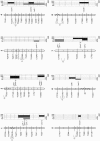Genetics of hybrid incompatibility between Lycopersicon esculentum and L. hirsutum
- PMID: 15466436
- PMCID: PMC1448897
- DOI: 10.1534/genetics.104.029546
Genetics of hybrid incompatibility between Lycopersicon esculentum and L. hirsutum
Abstract
We examined the genetics of hybrid incompatibility between two closely related diploid hermaphroditic plant species. Using a set of near-isogenic lines (NILs) representing 85% of the genome of the wild species Lycopersicon hirsutum (Solanum habrochaites) in the genetic background of the cultivated tomato L. esculentum (S. lycopersicum), we found that hybrid pollen and seed infertility are each based on 5-11 QTL that individually reduce hybrid fitness by 36-90%. Seed infertility QTL act additively or recessively, consistent with findings in other systems where incompatibility loci have largely been recessive. Genetic lengths of introgressed chromosomal segments explain little of the variation for hybrid incompatibility among NILs, arguing against an infinitesimal model of hybrid incompatibility and reinforcing our inference of a limited number of discrete incompatibility factors between these species. In addition, male (pollen) and other (seed) incompatibility factors are roughly comparable in number. The latter two findings contrast strongly with data from Drosophila where hybrid incompatibility can be highly polygenic and complex, and male sterility evolves substantially faster than female sterility or hybrid inviability. The observed differences between Lycopersicon and Drosophila might be due to differences in sex determination system, reproductive and mating biology, and/or the prevalence of sexual interactions such as sexual selection.
Figures




References
-
- Alpert, K. B., S. Grandillo and S. D. Tanksley, 1995. Fw-2.2—a major QTL controlling fruit weight is common to both red-fruited and green-fruited tomato species. Theor. Appl. Genet. 91: 994–1000. - PubMed
-
- Ashburner, M., 1989 Drosophila. Cold Spring Harbor Laboratory Press, Cold Spring Harbor, NY.
-
- Barton, N. H., and B. Charlesworth, 1984. Genetic revolutions, founder effects, and speciation. Annu. Rev. Ecol. Syst. 15: 133–164.
Publication types
MeSH terms
Substances
LinkOut - more resources
Full Text Sources
Other Literature Sources

